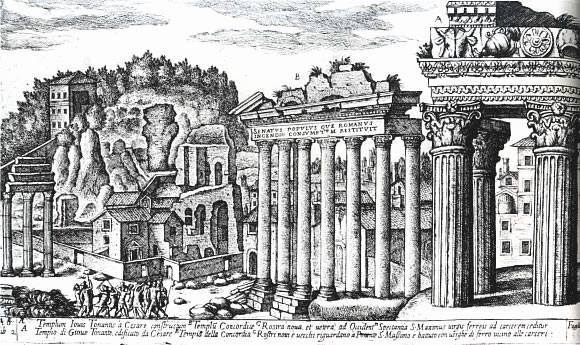Rome Renaissance in 12th century

Pasquale II, pope from 1099 to 1118, faced his pontificate with a clear program that also included an urban revolution of Rome.In twenty years he tried to give a new face to Rome; centuries of raids and destruction to the detriment of monuments, fires and floods had transformed the capital of the Roman Empire into a sequence of semi-collapsed buildings. Historians believe that the Pope's commitment to the arrangement of entire areas of Rome was closely linked to the need to create liturgical paths to be proposed to the many pilgrims who each year came to Rome.
Until his intervention in Rome was built over foundations of the ancient monuments, almost a natural change in the face of the city due to the passage of time. As evidence of this, there are the levels of the walking floors of the roads that in the high medieval period, and even a little later, were still those of the late ancient Roman age.
The intervention wanted by Pasquale II also responded to the need to arrange the road system put in serious crisis by the collapse of many ancient monuments due to earthquakes and fires and partly also to abandonment for the impossibility of repairing them without adequate resources. Many of the monuments were closed as early as 382 AD when the emperor Gratian with a decree had ordered the abolition of the privileges of the priestly colleges as well as the confiscation of the temples and of all their assets. The cancellation of paganism, initiated by the expropriation of worship places, was anyway accompanied by the desire to preserve these buildings considered "monumenta" of high artistic value so that the emperor Honorius in 399 issued an edict in which he ordered to protect the buildings of pagan worship and the artworks that contained as they were considered "ornamenta" not only of Rome but of the Empire; however not all the monuments were protected and already in the V century some of those had collapsed as for example the Porticus Minucia. But if the Eastern emperors succeeded in saving Rome from the will of the Christians to destroy all that was pagan in Rome, very little could be against the looting of the barbarians of 410 and 455: in the Roman Forum the Secretarium Senatus, the Curia, the Atrium Libertatis, the Basilica Julia, the Basilica Emilia and the Templum Pacis were looted and burned and then only a few were restored.
The basilica Emilia was no longer rebuilt, it was “spoliata” of every decoration and was rebuilt only the front porch, while the western side was closed with a wall with niches (which remained standing until at least the Renaissance); it became an empty monument, full, however, of meaning. The Temple of Peace was not restored and during recent excavations were found some pink granite columns unfortunately fragmented; however, the columns allowed the realization of a difficult and highly criticized anastylosis project in which the columns were raised, integrating the missing parts with modern materials.
The work that today is difficult, it was impossible in the XII century; along the ancient tracks were lying on the ground huge monolithic columns of granite that could not be removed and then the solution was to bury what was not possible to remove: it was decided to cover the ground by raising the altitude of the soil shares on average of four meters.
Some important monuments of Ancient Rome were saved in the essential structures but underwent a radical change, in particular in the Roman Forum carriyng on:
- the Curia Julia was transformed into a church as early as the 8th century, preserving its walls, floor and wall coverings, but adding the apse, and so it was also possible to maintain the same height as the ancient Roman building. The church, dedicated to S. Adriano, was very important as a starting point for many liturgical processions, precisely for this reason Pope Pasquale II wanted to restructure and embellish it. The renovation involved many interventions starting from the raising of the floor of mt. 3.40 and the internal division into three naves by two rows of columns. In 1932, as part of the revaluation project of Ancient Rome, it was decided to demolish the structures after the fourth century to restore the Roman monuments, among them there was also the church of S. Adriano from which all the medieval additions were dismantled so that It was possible to review the Curia Julia as it appeared at the time of Diocletian ...
Sign up and read the rest of the article!
by M.L. ©ALL RIGHTS RESERVED (Ed 1.0 - 19/06/2018)







Bibliography: